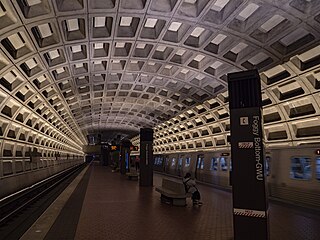
Foggy Bottom–GWU Kennedy Center is an island platformed Washington Metro station serving The George Washington University campus in the Foggy Bottom neighborhood of Washington, D.C., United States. The station was opened on July 1, 1977, and is operated by the Washington Metropolitan Area Transit Authority (WMATA). Providing service for the Blue, Silver, and Orange Lines, the station is located on I Street on the George Washington University (GWU) campus. It is the last westbound station in the District of Columbia on these lines before they dive under the Potomac River to Virginia.

Friendship Heights is a Washington Metro station straddling the border of Washington, D.C. and Montgomery County, Maryland, United States. The station was opened on August 25, 1984, and is operated by the Washington Metropolitan Area Transit Authority (WMATA).
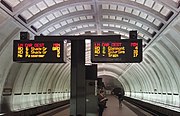
Bethesda is a rapid transit station on the Red Line of the Washington Metro system in Bethesda, Maryland. It is one of the busiest suburban Metro stations, serving on average 9,142 passengers each weekday in 2017. The Purple Line, currently under construction, will terminate at Bethesda, providing rail service to other inner Maryland suburbs such as Silver Spring and College Park, each of which has additional north-south connections by Washington Metro, and New Carrollton, which has Amtrak and MARC connections to both Washington, D.C. and Baltimore.

Rosslyn is the westernmost station on the shared segment of the Blue, Orange, and Silver lines of the Washington Metro. It is located in the Rosslyn neighborhood of Arlington, Virginia, United States. Rosslyn is the first station in Virginia heading westward from the District on the Orange and Silver Lines and southward on the Blue Lines. It is one of four interchange points on the Metrorail system west of the Potomac River and located in a growing business district.
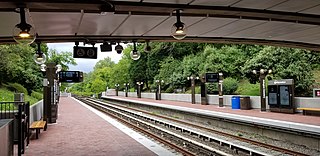
Arlington Cemetery is a side platformed Washington Metro station in Arlington, Virginia, United States. The station was opened on July 1, 1977, and is operated by the Washington Metropolitan Area Transit Authority (WMATA). The station provides service for only the Blue Line, and is located at the entrance to Arlington National Cemetery, underneath Memorial Drive. There is no public parking near the station except at the cemetery, which is reserved for cemetery visitors. It is the only station that closes earlier than the rest of the system, closing at 7 PM from October to March, and 10 PM from April to September.

L'Enfant Plaza is an intermodal transit station located at L'Enfant Plaza in the Southwest Federal Center neighborhood of Washington, D.C. It consists of an underground Washington Metro rapid transit station and an elevated Virginia Railway Express commuter rail station.
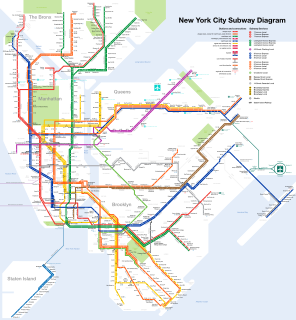
The New York City Subway is a rapid transit system that serves four of the five boroughs of New York City, New York: the Bronx, Brooklyn, Manhattan, and Queens. Its operator is the New York City Transit Authority, which is itself controlled by the Metropolitan Transportation Authority of New York. In 2015, an average of 5.65 million passengers used the system daily, making it the busiest rapid transit system in the United States and the seventh busiest in the world.

Snowdon station is a Montreal Metro station in the borough of Côte-des-Neiges–Notre-Dame-de-Grâce in Montreal, Quebec, Canada. It is operated by the Société de transport de Montréal (STM) and is a transfer station between the Orange Line and Blue Line; it is the western terminus of the Blue Line. It is located in the Snowdon neighbourhood. The town of Hampstead is located nearby to the west, across Macdonald Avenue.

The Lexington Avenue–63rd Street station is a New York City Subway station in Lenox Hill, Manhattan, shared by the IND and BMT 63rd Street Lines. Located at the intersection of Lexington Avenue and 63rd Street, it is served by the:

Logan Square is a subway station on the Chicago Transit Authority's 'L' system, serving the Blue Line and the Logan Square neighborhood. It was the terminus of the Milwaukee Elevated until it was extended to Jefferson Park in 1970 and to O'Hare Airport in 1984 via the Kennedy Expressway. From Logan Square, trains run at intervals of 2–7 minutes during rush-hour periods, and take 14 minutes to travel to the Loop. O'Hare bound trains take 26 minutes to reach the airport.

The Jay Street–MetroTech station is a New York City Subway station complex on the IND Fulton Street, IND Culver, and BMT Fourth Avenue lines. The complex is located in the vicinity of MetroTech Center in Downtown Brooklyn. It is served by the:
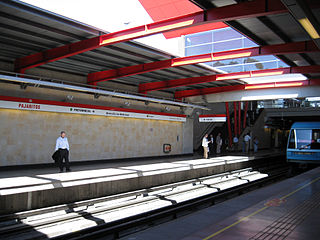
Pajaritos is a metro station on the Line 1 of the Santiago Metro, in Santiago, Chile. Ruta 68 and General Bonilla Avenue run parallel to the station. The station was opened on 15 September 1975 as part of the inaugural section of the line between San Pablo and La Moneda.

Macul is a metro station on the Line 4 of the Santiago Metro, in Santiago, Chile. The station occupies the central viaduct of three adjacent overpasses. The other elevated bridges carry three one-way lanes each of Vespucio Sur. It is located on the site of a former roundabout, where Américo Vespucio Avenue, La Florida Avenue, Macul Avenue and Departamental Avenue used meet. The latter ones currently pass under the aforementioned viaducts, as does a canal called Zanjón de la Aguada. The station was opened on 2 March 2006 as part of the connection between Grecia and Vicente Valdés.
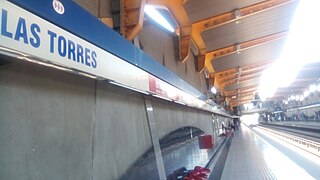
Las Torres is a freeway-median metro station on the Line 4 of the Santiago Metro, in Santiago, Chile. It is built into the median of Vespucio Sur expressway. The station is located immediately north of the cloverleaf interchange of Américo Vespucio Avenue and Las Torres Avenue, which is named so because it features high tension towers along its median. Las Torres Avenue gives its name to the station. The station was opened on 2 March 2006 as part of the connection between Grecia and Vicente Valdés.

Manquehue is an underground metro station on the Line 1 of the Santiago Metro, in Santiago, Chile. It is part of the 3.8 kilometres (2.4 mi) eastern extension of the Line 1. The station was opened on 7 January 2010 as part of the extension of the line from Escuela Militar to Los Dominicos,

La Cisterna is a station on the Santiago Metro in Santiago, Chile. It is an interchange between lines 2 and 4A, and consists of two parts, one built in an open trench and the other partially excavated, joined by pedestrian tunnels. The Line 2 platforms opened on 22 December 2004 as part of a 2.2 km (1.4 mi) southward extension of Line 2 from Lo Ovalle metro station. The Line 4A platforms opened on 16 August 2006 as part of the inaugural section of the line between Vicuña Mackenna and La Cisterna. It is named after La Cisterna, the district where the station is located and whose town hall is close to it.

República is an underground metro station on the Line 1 of the Santiago Metro, in Santiago, Chile. This station is named for República Avenue. The station was opened on 15 September 1975 as part of the inaugural section of the line between San Pablo and La Moneda.

Unión Latinoamericana, also known as ULA, is an underground metro station on the Line 1 of the Santiago Metro, in Santiago, Chile. It is close to Víctor Jara Stadium. The station was opened on 15 September 1975 as part of the inaugural section of the line between San Pablo and La Moneda.

Franklin is a transfer station between the Line 2 and Line 6 of the Santiago Metro. Their namesake is the Franklin Neighborhood. The Line 2 station was opened on 31 March 1978 as the southern terminus of the inaugural section of the line, from Los Héroes. On 21 December 1978, the line was extended to Lo Ovalle. The Line 6 station was opened on 2 November 2017 as part of the inaugural section of the line, between Cerrillos and Los Leones.

Cumming is an underground metro station on the Line 5 of the Santiago Metro, in Santiago, Chile. It is located underneath Catedral street in the commune of Santiago, between metro stations Quinta Normal and Santa Ana.





















